丙肝治疗新进展
丙肝最新治疗方案
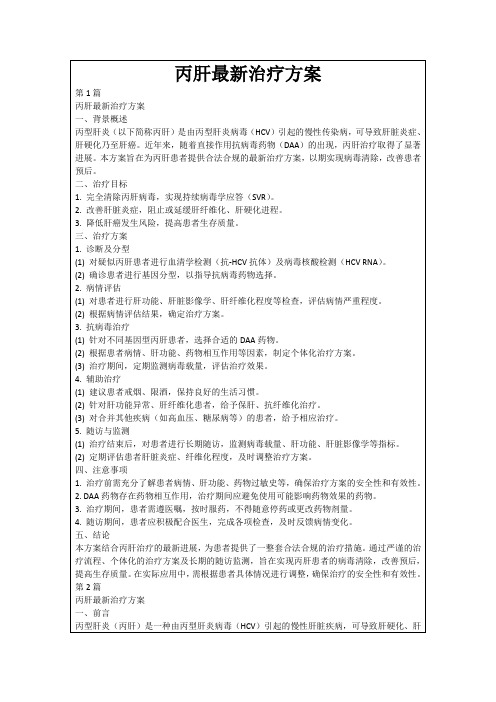
2.注意DAA药物与其他药物的相互作用,避免影响疗效。
3.治疗期间,患者需严格遵守医嘱,按时服药,不得擅自更改药物剂量。
4.随访期间,患者应积极配合医生,完成各项检查,及时反馈病情变化。
五、结论
本方案以丙肝治疗的最新进展为基础,为患者提供了一套合法合规的详细治疗方案。通过严谨的治疗流程、个体化的治疗方案、全面的病情监测和长期的随访管理,旨在实现丙肝患者病毒学治愈,改善肝脏功能,提高生活质量。在实际应用中,应根据患者具体情况灵活调整治疗方案,确保治疗的安全性和有效性。
二ห้องสมุดไป่ตู้治疗原则
1.个性化治疗:根据患者具体病情、病毒基因型、肝脏损害程度及合并症等情况制定个体化治疗方案。
2.规范化治疗:遵循国内外最新丙肝治疗指南,合理选择和使用DAA药物。
3.安全性优先:在确保治疗效果的同时,重视药物安全性,减少不良反应。
4.长期管理:治疗结束后,对患者进行长期随访,监测病毒学及肝脏功能指标。
4.辅助治疗
(1)建议患者戒烟、限酒,保持良好的生活习惯。
(2)针对肝功能异常、肝纤维化患者,给予保肝、抗纤维化治疗。
(3)对合并其他疾病(如高血压、糖尿病等)的患者,给予相应治疗。
5.随访与监测
(1)治疗结束后,对患者进行长期随访,监测病毒载量、肝功能、肝脏影像学等指标。
(2)定期评估患者肝脏炎症、纤维化程度,及时调整治疗方案。
5.辅助治疗
-建议患者改善生活习惯,如戒烟、限酒,保持适当运动。
-对肝功能异常、肝纤维化患者,给予保肝、抗纤维化治疗。
-针对患者合并的其他疾病,给予相应治疗和干预。
6.随访与评估
疾控中心丙肝治疗工作进展情况汇报材料

疾控中心丙肝治疗工作进展情况汇报材料疾控中心丙肝治疗工作进展情况汇报一、引言近年来,丙肝成为全球公共卫生领域的重要问题之一。
为了加强对丙肝的防控工作,我中心积极组织相关专家开展研究,并推动丙肝治疗工作的进展。
本文将详细介绍我中心在丙肝治疗方面的工作进展情况。
二、丙肝治疗现状丙肝是由丙型肝炎病毒(HCV)感染引起的慢性传染性疾病。
根据统计数据,全球约有7,100万人感染了HCV,其中中国占到了相当大的比例。
长期以来,由于缺乏有效的治疗手段和高昂的药物费用,丙肝患者往往面临着长期抑郁和身体不适的困扰。
三、我中心在丙肝治疗方面所做的努力为了改善丙肝患者的生活质量和减少传播风险,我中心在以下几个方面做出了努力:1. 促进药物研发我中心与多家药企合作,共同研发新型丙肝治疗药物。
通过对HCV的基因序列进行分析和研究,我们成功开发出一种具有高效抗病毒活性的新药,并已经开始进行临床试验。
该药物在抑制HCV复制方面表现出色,预计将为患者提供更好的治疗选择。
2. 推广先进治疗技术我中心与国内外多家知名医院开展合作,邀请专家来中心进行培训和指导。
通过学习和掌握先进的丙肝治疗技术,我们能够更好地为患者提供个性化、精准的治疗方案。
同时,我们还积极推广使用自动化检测设备,提高检测效率和准确度。
3. 加强宣传教育为了提高公众对丙肝的认识和防控意识,我中心组织了一系列宣传教育活动。
我们开展了丙肝知识普及讲座、健康教育活动等,并通过媒体渠道广泛传播相关信息。
这些活动有效地提高了公众对丙肝的认知水平,促进了社会对丙肝防控工作的支持。
四、丙肝治疗工作取得的成绩通过我们的努力,取得了以下几方面的成绩:1. 药物研发取得突破我们成功开发出一种新型丙肝治疗药物,并已经获得国家药品监督管理局的批准。
该药物在治疗效果和安全性方面表现出色,为患者提供了更好的治疗选择。
2. 治愈率显著提高通过推广先进治疗技术和个性化治疗方案,我们成功提高了丙肝患者的治愈率。
中国丙肝流行病学与规范化治疗新进展

0.33
64123
0.31
人群
吸毒者 男性STD就诊者 暗娼 男男性行为者 男性流动人口 长卡司机 青年学生 孕产妇
检测人数
HCV抗体 阳性率%
117560
38.43
147422
0.72
207424
0.69
42579
0.67
34735
0.45
22953
0.42
52250
0.18
150907
0.16
专业材2料0,1仅3年供医监药专测业哨人员点参考HCV抗体检测结果:共检测894906人,HCV抗体阳性检出率5.50%
21145
39380
52927
70681
2003 2004 2005 2006 2007 2008 2009 2010 2011 2012 2013
专业材料,仅供医药专业人员参考 材料编号:P-PGS-2014.11-125 Valid Until 2016.11 上海罗氏制药有限公司
1. Duan ZP, et al. J Clin Gastroenterol 2014;48:679-686. 2. 国家卫生计生委疾病预防控制局. 2013年度全国法定传染病疫情情况. http://
我国丙肝报告率的分布逐年呈扩大趋势
专业材料,仅供医药专业人员参考 材料编号:P-PGS-2014.11-125 Valid Until 2016.11 上海罗氏制药有限公司
秦倩倩, 等. 中华流行病学杂志, 2013, 34(6): 548-551.
部分农村地区HCV流行率较高
根据居住人口分类
报告例数
Rao HY, et al.J Gastroenterol Hepato, 2014, 29: 545-553.
丙肝不可怕丙肝的抗病毒治疗

Hadziyannis SJ. EASL Annual Meeting. 2002.
942研究:疗效小结
派罗欣® 联合 利巴韦林 1000/1200 mg/日治疗 48 周,持续性病毒学应答率 61% 派罗欣® 联合 利巴韦林 1000/1200 mg/日治疗 48 周,HCV 基因型 1 型持续性病毒学应答率 51% 派罗欣® 联合 利巴韦林 800 mg/日治疗 24 周,HCV 基因型非 1 型持续性病毒学应答率 78%
65% (n = 253)
Hadziyannis SJ. EASL Annual Meeting. 2002.
所有患者治疗结束后随访24周
派罗欣® 180 mg sc qw + 利巴韦林 800 mg qd, 24 周
派罗欣® 180 mg sc qw + 利巴韦林 1000/1200 mg qd, 24 周
派罗欣® 180 mg sc qw + 利巴韦林 1000/1200 mg qd, 48 周
开发聚乙二醇干扰素经历了2代技术
IFN
第一代聚乙二醇干扰素α-2b(12KD)
吸收过快,峰浓度高
PEG位点多样,产品均一性差
分布过广,剂量要大
PEG与干扰素结合不稳定需要制成干粉剂
消除过速,给药要频
在体内分布仍很广泛
波动过大,耐受性差
不能保证稳定1周的血药浓度
第二代大分子支链 PEG干扰素纯度更高
目前治疗丙肝的临床药物
干扰素类 普通干扰素(IFN) 聚乙二醇干扰素 利巴韦林
IFN
第一代聚乙二醇干扰素α-2b(12KD)
第二代聚乙二醇干扰素α-2a派罗欣®(40KD)
丙型肝炎的治疗进展

随访
n=72
270 μg
PEGASYS® 180 μg/wk
随访
+ COPEGUS® 1000–1200mg/day 360 μg PEGASYS® 180 μg/wk 随访
+ COPEGUS® 1000–1200mg/day
0
随机化
12
24
36 研究周数
48
60
72
Diago M, et al. 55th AASLD 2004; Abstract 522
80% % Patients with VR 70% 60% 50% 40% 30% 20% 10% 0% Week 12
ITT; 丢失 = 失败
38%
WeБайду номын сангаасk 48
Week 72
Fried et al. AASLD 2006
西班牙高剂量诱导试验 --对普通干扰素无应答者使用派罗欣联合治疗
PEGASYS® 180 μg/wk + COPEGUS® 1000–1200 mg/day
所有病人在治疗结束后随访24周
Hadziyannis S, et al. Ann Intern Med 2004; 140: 346
因1型患者,无论基线病毒载量如何,48 周疗程优于24周
派罗欣180微克联合利巴韦林 100 80
65% 24-LD A组 24-SD B组 48-LD C组 48-SD D组 47% 36% 26% 16% n= 51 71 60 85 50 47 190 186 55%
2004年中国《丙型肝炎防治指南》
抗病毒的目的:是清除或长期抑制体内的 HCV,以改善和减轻肝损害、阻止进展为肝 硬化、肝衰竭或HCC,并提高患者的生活质 量。 抗病毒的适应症:只有确诊为血请HCVRNA 阳性的丙型肝炎患者才需要抗病毒治疗。
治疗丙肝的最新药物是什么

治疗丙肝的最新药物是什么丙肝是我国临床比较常见的一种肝病,它如果是没有得到有效的治疗很容易会导致肝硬化出现,甚至有可能会引起肝腹水,如果是这样的话就会给患者的生命带来威胁,由此可见治疗丙肝的重要性。
不过丙肝使用传统的治疗药物治疗的时候有一定的局限性,因此医学界一直都在研究治疗丙肝的最新药物。
近日,美国得克萨斯州大学研究人员在美国《新英格兰医学杂志》网络版及正在伦敦举行的国际肝病大会上报告说,他们研制了一种不含干扰素的药物,此药物对肝硬化丙肝患者的治愈率甚至可达95%。
他们于2013年在英国、西班牙、德国和美国的78家医院随机选取了380名同时患有肝硬化的丙肝患者,将其分为两组,使用新药分别进行了为期12周和24周的治疗。
结果显示,接受12周治疗的208名患者中,191人在疗程结束后血液中检测不出丙肝病毒,治愈率达91.8%;而接受24周治疗的172名患者中,165人的血液中检测不出丙肝病毒,治愈率达到95.9%。
研究人员还表示,这种新药的药物耐受性也比较好,这对于患有肝硬化的丙肝患者来说也是个好消息。
研究人员预计,此药有望在今年年底或2015年初进行市场化生产。
在日常生活中要不断对自己的身体进行检查,同时在生活中出现了不适的症状后,也应该及时到医院进行相应的检查,千万不能大意,确定病情后,要及时、积极接受科学治疗。
丙肝是由肝病毒引起,容易导致肝硬化甚至肝癌,主要传播途径为:输血、血液透析、肾移植、静脉注射毒品、不洁性关系以及母婴传播等。
对于治疗丙肝的最新药物以及该病要如何治疗本文都为您做出了介绍,其实对于丙肝疾病是有一定的预防措施的,比如说医院在为病人进行治疗的时候最好是使用一次性的注射用句,平时养成良好的生活习惯不要接触丙肝患者等,这些都是预防丙肝的方法。
2023年丙肝治疗方法及治疗原则 丙肝有哪些症状表现
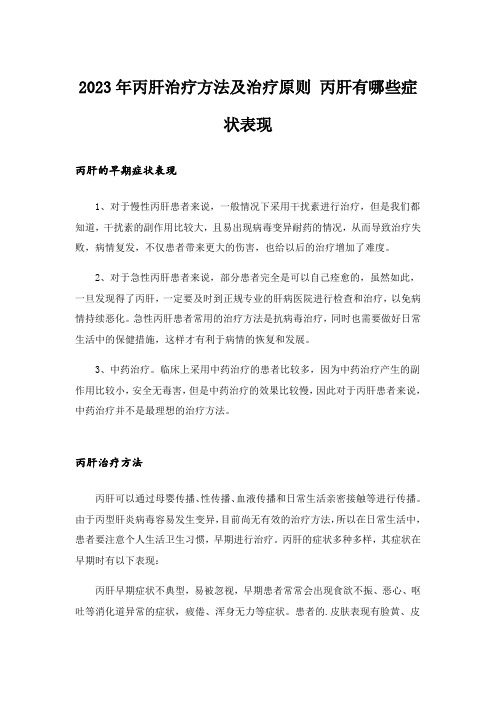
2023年丙肝治疗方法及治疗原则丙肝有哪些症状表现丙肝的早期症状表现1、对于慢性丙肝患者来说,一般情况下采用干扰素进行治疗,但是我们都知道,干扰素的副作用比较大,且易出现病毒变异耐药的情况,从而导致治疗失败,病情复发,不仅患者带来更大的伤害,也给以后的治疗增加了难度。
2、对于急性丙肝患者来说,部分患者完全是可以自己痊愈的,虽然如此,一旦发现得了丙肝,一定要及时到正规专业的肝病医院进行检查和治疗,以免病情持续恶化。
急性丙肝患者常用的治疗方法是抗病毒治疗,同时也需要做好日常生活中的保健措施,这样才有利于病情的恢复和发展。
3、中药治疗。
临床上采用中药治疗的患者比较多,因为中药治疗产生的副作用比较小,安全无毒害,但是中药治疗的效果比较慢,因此对于丙肝患者来说,中药治疗并不是最理想的治疗方法。
丙肝治疗方法丙肝可以通过母婴传播、性传播、血液传播和日常生活亲密接触等进行传播。
由于丙型肝炎病毒容易发生变异,目前尚无有效的治疗方法,所以在日常生活中,患者要注意个人生活卫生习惯,早期进行治疗。
丙肝的症状多种多样,其症状在早期时有以下表现:丙肝早期症状不典型,易被忽视,早期患者常常会出现食欲不振、恶心、呕吐等消化道异常的症状,疲倦、浑身无力等症状。
患者的.皮肤表现有脸黄、皮肤黄等症状。
患者容易出现发烧、右上腹功能不适、尿液发黄等症状,当出现这些症状时,患者要注意早期进行治疗。
慢性丙肝早期可出现不同程度的乏力、头晕、食欲有所减退、可有肝大和轻度触痛触痛。
部分患者无任何明显症状和体征。
严重时丙肝症状明显,患者常伴肝病面容、肝掌,丙肝合并乙肝感染时往往表现症状突然加重。
丙肝的治疗原则是什么1、把干扰素作为丙肝治疗的首选药物。
长效干扰素是目前公认的治疗丙肝最好的方法,丙肝患者在经济条件允许的情况下,应该首先使用长效干扰素。
如果经济条件不好,则可以选用普通干扰素和复合干扰素。
2、使用干扰素进行丙肝治疗时还要有足够的疗程。
早期应答的获得,预示着患者若坚持使用干扰素治疗一年以上便可以获得较为满意的疗效目前主张,用干扰素治疗丙肝一旦奏效,就应该坚持使用干扰素治疗1年以上。
丙肝最新治疗方案

丙肝最新治疗方案摘要丙肝是一种由丙型肝炎病毒(HCV)感染引起的肝炎。
丙肝感染已成为全球公共卫生问题,而丙肝的治疗一直是临床医生和患者关注的重点。
随着科学技术的不断发展,丙肝的治疗方案也在不断更新和改进。
本文将介绍丙肝最新治疗方案的相关内容。
引言丙肝是一种慢性肝病,由丙型肝炎病毒(HCV)感染引起。
丙肝感染的人数众多,世界卫生组织(WHO)估计全球约有7100万人感染HCV,其中大部分人都发展成了慢性丙肝。
长期丙肝感染可能导致肝硬化、肝癌等严重后果。
因此,丙肝的治疗一直是医学界和患者关注的焦点。
传统治疗方案过去,丙肝的治疗主要依赖干扰素(IFN)和利巴韦林(Ribavirin)这两种药物。
然而,这种传统治疗方案的疗效并不理想,治疗周期长(通常12-48周),且患者常常出现严重的不良反应。
此外,该治疗方案无法对所有患者产生有效的治疗效果,导致治愈率较低。
直接抗病毒药物(Direct-Acting Antivirals,DAAs)的出现在过去的几年中,直接抗病毒药物(DAAs)的出现彻底改变了丙肝的治疗格局。
DAAs是一类对HCV直接起作用的药物,它们通过抑制HCV在人体内的复制,从而达到治疗的目的。
相比传统治疗方案,DAAs具有更高的疗效和更短的治疗周期。
丙肝最新治疗方案DAAs的组合疗法DAAs的组合疗法是丙肝最新的治疗方案之一。
这种治疗方案将两种或多种DAAs药物联合使用,从而增加疗效。
一些常用的DAAs药物包括:苯达韦(Sofosbuvir)、利巴韦林、阿巴卡韦(Ombitasvir)和达肽韦(Dasabuvir)。
根据患者的病毒基因分型,医生可以选择适当的DAAs组合方案,以提高治疗效果。
个体化治疗近年来,针对不同患者的基因型和病毒负荷,个体化治疗成为了临床实践的重要方向。
通过对患者的基因分型进行检测,医生可以选择针对特定基因型的DAAs药物进行治疗,从而提高治疗效果。
此外,患者的病毒负荷情况也会影响治疗的选择和疗效评估。
慢性丙肝患者抗病毒治疗的护理进展

慢性丙肝患者抗病毒治疗的护理进展摘要:慢性丙肝是一种常见的肝病,抗病毒治疗是目前最有效的治疗方法。
在抗病毒治疗期间,护理工作起着重要的作用,包括护理评估和监测、患者教育、药物管理和心理支持等方面。
护理人员需要具备丰富的临床经验和专业知识,帮助患者建立正确的治疗观念,提高治疗依从性。
通过加强护理工作,可以提高慢性丙肝患者抗病毒治疗的效果,改善患者的生活质量。
关键词:慢性;丙肝患者;抗病毒治疗;护理进展1.引言慢性丙型肝炎是一种常见的肝炎疾病,由丙型肝炎病毒(HCV)感染引起。
随着医学科技的不断进步,慢性丙肝患者抗病毒治疗的护理工作也在不断取得新的进展。
本文将探讨慢性丙肝患者抗病毒治疗的护理进展,并就护理实践中的关键问题进行讨论。
2.护理进展(一)护理评估和监测慢性丙肝患者在接受抗病毒治疗前,需要进行全面的护理评估。
这包括对患者病史的采集,了解病情发展情况、曾经接受过的治疗方案等信息。
同时,护理人员还需要进行全面的体格检查,包括皮肤、黏膜、淋巴结、肝脾大小等方面的检查。
此外,肝功能评估也是必不可少的,护理人员需要对患者进行肝功能的评估,包括血清谷丙转氨酶(ALT)、血清谷草转氨酶(AST)、总胆红素、白蛋白等指标的检测。
另外,病毒学指标评估也是重要的一环,护理人员需要对患者进行病毒学指标的评估,包括病毒载量、基因分型等指标的检测。
在治疗期间,护理人员需要密切监测患者的病情变化。
这包括肝功能、病毒学指标、药物不良反应等方面的监测,以便及时发现并处理治疗过程中的并发症和不良反应。
护理人员还需要定期检测患者的肝功能指标,如ALT、AST、总胆红素等,以及病毒学指标,如病毒载量、基因分型等,以评估治疗效果,并及时调整治疗方案[1]。
此外,护理人员还需要密切关注患者是否出现药物不良反应,如恶心、呕吐、头痛、皮疹等,并及时处理并报告医生。
同时,护理人员还需要留意患者是否出现并发症,如贫血、肝硬化等,并及时处理并报告医生。
小分子药物治疗丙型肝炎的疗效和安全性
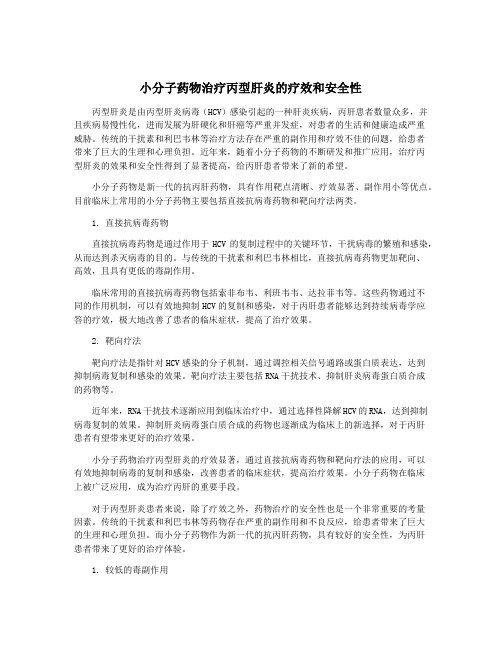
小分子药物治疗丙型肝炎的疗效和安全性丙型肝炎是由丙型肝炎病毒(HCV)感染引起的一种肝炎疾病,丙肝患者数量众多,并且疾病易慢性化,进而发展为肝硬化和肝癌等严重并发症,对患者的生活和健康造成严重威胁。
传统的干扰素和利巴韦林等治疗方法存在严重的副作用和疗效不佳的问题,给患者带来了巨大的生理和心理负担。
近年来,随着小分子药物的不断研发和推广应用,治疗丙型肝炎的效果和安全性得到了显著提高,给丙肝患者带来了新的希望。
小分子药物是新一代的抗丙肝药物,具有作用靶点清晰、疗效显著、副作用小等优点。
目前临床上常用的小分子药物主要包括直接抗病毒药物和靶向疗法两类。
1. 直接抗病毒药物直接抗病毒药物是通过作用于HCV的复制过程中的关键环节,干扰病毒的繁殖和感染,从而达到杀灭病毒的目的。
与传统的干扰素和利巴韦林相比,直接抗病毒药物更加靶向、高效,且具有更低的毒副作用。
临床常用的直接抗病毒药物包括索非布韦、利班韦韦、达拉菲韦等。
这些药物通过不同的作用机制,可以有效地抑制HCV的复制和感染,对于丙肝患者能够达到持续病毒学应答的疗效,极大地改善了患者的临床症状,提高了治疗效果。
2. 靶向疗法靶向疗法是指针对HCV感染的分子机制,通过调控相关信号通路或蛋白质表达,达到抑制病毒复制和感染的效果。
靶向疗法主要包括RNA干扰技术、抑制肝炎病毒蛋白质合成的药物等。
近年来,RNA干扰技术逐渐应用到临床治疗中,通过选择性降解HCV的RNA,达到抑制病毒复制的效果。
抑制肝炎病毒蛋白质合成的药物也逐渐成为临床上的新选择,对于丙肝患者有望带来更好的治疗效果。
小分子药物治疗丙型肝炎的疗效显著,通过直接抗病毒药物和靶向疗法的应用,可以有效地抑制病毒的复制和感染,改善患者的临床症状,提高治疗效果。
小分子药物在临床上被广泛应用,成为治疗丙肝的重要手段。
对于丙型肝炎患者来说,除了疗效之外,药物治疗的安全性也是一个非常重要的考量因素。
传统的干扰素和利巴韦林等药物存在严重的副作用和不良反应,给患者带来了巨大的生理和心理负担。
丙肝最新治疗方案

丙肝最新治疗方案导言丙肝,即丙型肝炎,是由丙型肝炎病毒(HCV)引起的病毒性肝炎,是全球范围内的一个重要公共卫生问题。
丙肝的传播途径主要是经血液传播,其主要特征是潜伏期长、发病隐匿、易变异、复制速度快,导致了该疾病的难治性。
然而,随着科学技术的进步和研究的深入,丙肝的治疗方案也在不断更新和进化。
本文将介绍丙肝最新的治疗方案。
1. 丙肝的治疗策略目前,丙肝的治疗策略主要包括以下几个方面:1.1. 病毒复制水平检测在制定丙肝治疗方案之前,首先需要检测病毒复制水平。
常用的方法是血清HCV RNA定量检测技术。
1.2. 丙肝的基础治疗基础治疗是指使用干扰素和核苷酸逆转录酶抑制剂(NRTI)来抑制病毒复制。
这种治疗方案已经发展了很长时间,但其临床疗效有限,耐药性问题较突出。
1.3. 直接抗病毒药物(DAAs)的应用近年来,随着直接抗病毒药物的研制与应用,丙肝的治疗进展迅速。
与基础治疗相比,DAAs具有更高的疗效、更低的不良反应,并且可以通过合理的方案组合和个体化的治疗来提高治愈率。
2. 丙肝最新治疗方案2.1. 直接抗病毒药物目前,FDA已经批准了多种直接抗病毒药物用于丙肝的治疗,包括抗HCV NS3/4A蛋白酶药物、抗HCV NS5B核苷类/非核苷逆转录酶抑制剂和抗HCV NS5A 蛋白抑制剂等。
2.2. 个体化治疗根据丙肝患者的基因型、临床特征和肝功能等不同情况,可以制定个体化的治疗方案。
这意味着不同患者可能会得到不同的直接抗病毒药物组合方案,以提高治疗效果。
2.3. 治疗时间和疗程与传统的丙肝治疗方案相比,新的治疗方案疗程更短,治疗时间更短。
一些研究结果显示,在使用DAAs治疗6-12周后,丙肝的痊愈率可达到90%以上。
2.4. 监测疗效和不良反应在进行丙肝治疗期间,需要定期监测疗效和不良反应。
常见的监测指标包括血清HCV RNA定量、肝功能、ALT、AST和血常规等。
3. 丙肝治疗的挑战与前景3.1. 耐药性问题目前,直接抗病毒药物对于某些丙肝患者可能会出现耐药性问题。
丙肝最新治疗方法

丙肝最新治疗方法
目前丙肝的最新治疗方法主要包括直接抗病毒药物(直接抗病毒药物),如直接抑制病毒复制和传播的直接抗病毒药物,以及免疫调节剂如干扰素。
以下是一些常用的丙肝治疗方法:
1. 直接抗病毒药物(直接抗病毒药物):如抗病毒核苷类似物,如索非布韦/利巴韦林和达卡他韦/阿拉伯韦林等,这些药物能够直接抑制病毒的复制和传播。
2. 干扰素:干扰素是一种免疫调节剂,可以增强机体免疫反应,从而达到抑制病毒复制的效果。
目前丙肝治疗中,干扰素主要应用于特定人群,如联合直接抗病毒药物治疗失败的患者。
3. 抗纤维化治疗:丙肝感染可能导致肝纤维化和肝硬化等肝脏损害,因此,抗纤维化治疗也是丙肝治疗的重要一环。
包括抗纤维化药物和肝移植等方法。
总之,丙肝的最新治疗方法主要是直接抗病毒药物的应用和干扰素的使用,结合抗纤维化治疗,能够有效控制病毒复制,减轻肝脏损害,并提高治疗效果。
但是具体的治疗方案需要根据患者的具体情况、病毒株型、病情严重程度等因素来决定。
因此,建议患者在接受治疗前向医生咨询,制定适合自己的治疗方案。
丙型肝炎新型治疗药物的研究最新进展

丙型肝炎新型治疗药物的研究最新进展丙型肝炎,作为一种严重威胁人类健康的疾病,多年来一直备受医学界的关注。
过去,丙肝的治疗方法有限,效果也不尽如人意。
然而,随着医学研究的不断深入和科技的飞速发展,新型治疗药物的出现为丙肝患者带来了新的希望。
近年来,直接抗病毒药物(DAAs)的研发和应用成为了丙肝治疗领域的重大突破。
DAAs 能够直接作用于丙肝病毒复制过程中的关键靶点,从而高效地抑制病毒的复制和传播。
与传统的治疗方案相比,DAAs 具有更高的治愈率、更短的治疗周期以及更少的副作用。
其中,NS3/4A 蛋白酶抑制剂是一类重要的 DAA 药物。
这类药物通过抑制丙肝病毒 NS3/4A 蛋白酶的活性,阻止病毒多聚蛋白的切割和成熟,从而发挥抗病毒作用。
代表性的药物如索磷布韦维帕他韦片,在临床试验中表现出了卓越的疗效,对于基因 1-6 型丙肝患者的治愈率均能达到较高水平。
NS5A 抑制剂也是 DAA 药物中的重要成员。
它们通过与丙肝病毒NS5A 蛋白结合,干扰病毒的复制和组装。
例如达拉他韦、奥比帕利等药物,在与其他药物联合使用时,能够显著提高丙肝的治愈率。
除了以上两类药物,NS5B 聚合酶抑制剂同样在丙肝治疗中发挥着重要作用。
NS5B 聚合酶是丙肝病毒 RNA 复制所必需的酶,NS5B 聚合酶抑制剂能够选择性地抑制该酶的活性,从而阻止病毒 RNA 的合成。
根据作用机制的不同,NS5B 聚合酶抑制剂又分为核苷类和非核苷类。
核苷类抑制剂如索磷布韦,具有高选择性和低耐药性的特点;非核苷类抑制剂如波西普韦,也在丙肝治疗中展现出了良好的效果。
在新型治疗药物的研发过程中,药物的安全性和耐受性始终是关注的重点。
由于丙肝患者往往合并其他基础疾病,如肝硬化、糖尿病、心血管疾病等,因此新型药物在设计和临床试验阶段就充分考虑了这些因素。
许多 DAA 药物在临床试验中显示出了良好的安全性,肝肾功能损害、血液系统异常等不良反应的发生率相对较低。
丙型肝炎的治疗进展与抗病毒治疗不良反应处理-3002-2020年华医网继续教育答案
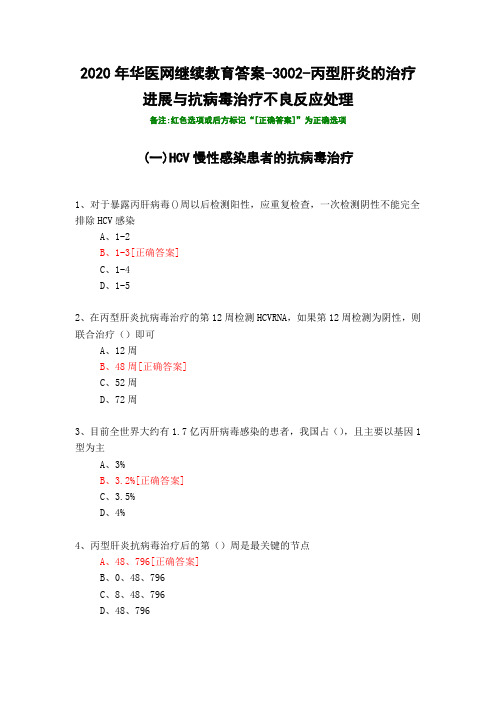
2020年华医网继续教育答案-3002-丙型肝炎的治疗进展与抗病毒治疗不良反应处理
备注:红色选项或后方标记“[正确答案]”为正确选项
(一)HCV慢性感染患者的抗病毒治疗
1、对于暴露丙肝病毒()周以后检测阳性,应重复检查,一次检测阴性不能完全排除HCV感染
A、1-2
B、1-3[正确答案]
C、1-4
D、1-5
2、在丙型肝炎抗病毒治疗的第12周检测HCVRNA,如果第12周检测为阴性,则联合治疗()即可
A、12周
B、48周[正确答案]
C、52周
D、72周
3、目前全世界大约有1.7亿丙肝病毒感染的患者,我国占(),且主要以基因1型为主
A、3%
B、3.2%[正确答案]
C、3.5%
D、4%
4、丙型肝炎抗病毒治疗后的第()周是最关键的节点
A、48、796[正确答案]
B、0、48、796
C、8、48、796
D、48、796。
丙型肝炎治疗新进展海南丙肝医院
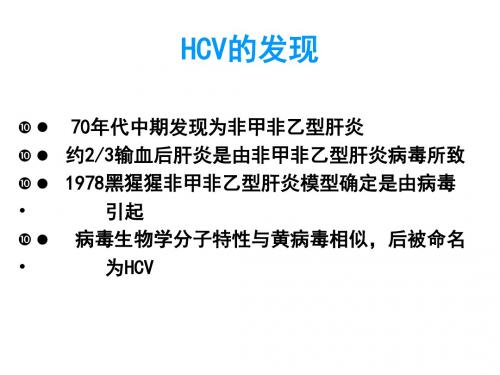
341nt
C
E1
NS2
NS3
NS4A
BNS5AFra bibliotekB27.43nt
(A)nor )n
衣壳 高变区 包膜 蛋白 蛋白
疏水膜 蛋白
解旋酶 疏水 膜蛋白
RNA多聚酶
HCV基因结构模拟图
l
•
•
•
• •
3’NCR---高度变异、Poly(u)、Poly(u/c)及98个 碱基高度保守区组成 l 5’NCR--340核苷酸组成,形成一个环柄杆结 构(stem-loop) l两端中间为开放读框(ORF)--9000个核苷酸 l E1编码的糖蛋白可能不是单一蛋白,而有二 种或更多 l 3’端的ORF编码的非结构蛋白,至少包括6种 蛋白,包括蛋白酶、解旋酶、多种RNA聚合 酶及调节肽等 l 4a基因产生的调节肽具有多种功能
• 抗体检测用酶免疫测定法(EIA)------优点 多,方便、重复性好、成本低 • EIA-1是用HCV-NS4基因段重组抗原,命名为 C100-3--------敏感性及特异性均不理想 • 仅80%患者HCV抗体阳性 • 假阳性很高
筛选试验——HCV抗体测定
第二代HCV抗体
• EIA-2(1992)试验含有NS4、核心及NS3基因抗
原-----代表了多种抗原 • 敏感性及特异性有改善 • HCV血清阳转平均窗口期(window periods) 明显缩短 • 血清阳转的平均时间 EIA-2----10周左右 EIA-1------16周 • 阳性率为95%
筛选试验——HCV抗体测定
第三代HCV抗体测定
• EIA-3含有重建核心和NS3抗原及NS5抗原
HCV准基因株与宿主免疫反应
疾控中心丙肝治疗工作进展情况汇报材料

疾控中心丙肝治疗工作进展情况汇报材料疾控中心丙肝治疗工作进展情况汇报材料近年来,丙肝已成为全球公共卫生领域关注的热点话题之一。
丙肝病毒感染是一种慢性病病毒性肝炎,会导致肝硬化和肝癌等严重后果。
为了有效预防和治疗丙肝,疾控中心积极推进相关工作并取得了一定的进展。
现在,我将向大家汇报一下疾控中心在丙肝治疗工作方面的最新情况。
一、丙肝治疗策略的改进1. 疫苗研发与普及丙肝疫苗的研发一直是疾控中心的重点工作之一。
我们对流行病学数据进行了分析,制定了有效的疫苗研发策略。
通过与相关研究机构合作,我们成功研发了丙肝疫苗,并在全国范围内推广普及。
这一举措有效地降低了丙肝的感染率,为控制疾病传播奠定了坚实基础。
2. 创新药物的应用疾控中心在丙肝治疗药物方面积极开展新药研发和应用工作。
我们投入大量资源,对现有药物进行改良和优化,提高了疗效和安全性。
我们与国内外制药企业建立合作关系,引进新药并将其应用于临床。
这些创新药物的应用为患者提供了更多的治疗选择,提高了治疗效果和患者生活质量。
二、丙肝防控工作的加强1. 宣传教育与体检疾控中心积极开展丙肝宣传教育工作,通过各类媒体渠道向公众普及丙肝的知识和预防措施。
我们定期组织丙肝相关的健康宣传活动,提高了公众对丙肝的认识和关注度。
我们加强了对丙肝的早期筛查和定期体检工作,帮助早期发现和诊断丙肝感染者,及时采取治疗措施。
2. 治疗服务体系的建设为了提高丙肝感染者的就医率和治疗质量,疾控中心在全国范围内建立了丙肝治疗服务体系。
该体系包括丙肝专科医疗机构、专业医生队伍和完善的医疗服务流程。
疾控中心与各级卫生部门开展合作,通过开设远程门诊和传统门诊相结合的形式,为丙肝感染者提供规范的治疗服务。
三、疫情监测与数据分析1. 疫情监测体系的搭建为了做好丙肝疫情监测工作,疾控中心搭建了一套全面、科学的监测体系。
我们建立了丙肝感染者登记管理系统,全面记录感染者的基本信息和治疗情况。
我们与各级卫生部门建立了信息共享平台,及时获取全国范围内的丙肝疫情数据,为科学决策提供了可靠依据。
丙肝最新治疗方案有哪些呢?

丙肝最新治疗方案有哪些呢?丙肝这个名字大家经常听到,其全称是丙型病毒性肝炎,由此可知,这种疾病主要是病毒的感染而导致的,丙肝具有一定的传染性,所以人们都比较害怕。
科学上一直在研究治疗丙肝的方法,但丙肝有不同的分类,不同类别的治疗措施也不一样。
★一、抗病毒治疗1、抗病毒治疗的目的抗病毒治疗的目的是清除或持续抑制体内的HCV,以改善或减轻肝损害、阻止进展为肝硬化、肝衰竭或HCC,并提高病人的生活质量。
2、抗病毒疗效判定。
3、抗病毒治疗的适应证只有确诊为血清HcV-RNA阳性的丙型肝炎病人才需要抗病毒治疗。
★二、急性丙型肝炎急性期HCV感染的最佳治疗方案尚未确定,可将治疗推迟至急性肝炎发作后8~12周进行。
如仍检测到HCV-RNA阳性,即应开始抗病毒治疗。
普通IFNα3-MU,隔日1次肌内或皮下注射,疗程为24周,丙型病毒性肝炎的治疗应同时服用利巴韦林800~l000mg/d。
★三、慢性丙型肝炎①ALT或AST持续或反复升高,或肝组织学有明显炎症坏死(G≥2)或中度以上纤维化(S≥2)者,易进展为肝硬化,应给予积极治疗。
②ALT持续正常者大多数肝病变较轻,应根据肝活检病理学结果决定是否治疗。
对已有明显纤维化(s2、S3)者,无论炎症坏死程度如何,均应给予抗病毒治疗;对轻微炎症坏死且无明显纤维化(S0、S1)者,可暂不治疗,但每隔3~6个月应检测肝功能。
③ALT水平并不是预测病人对IFNα应答的重要指标。
对于ALT正常或轻度升高的丙型肝炎病人,只要HCV-RNA阳性,也可进行治疗。
★四、丙型肝炎肝硬化①代偿期肝硬化(Child-PughA级)病人,尽管对丙型病毒性肝炎的治疗的耐受性和效果有所降低,但为使病情稳定、延缓或阻止肝衰竭和HCC等并发症的发生,建议在严密观察下给予抗病毒治疗。
②失代偿期肝硬化病人,多难以耐受IFNα治疗的不良反应,有条件者应行肝脏移植术。
★五、肝移植后丙型肝炎复发HCV相关的肝硬化或HCC病人经肝移植后,HCV感染复发率很高。
丙型肝炎病毒感染治疗药物进展
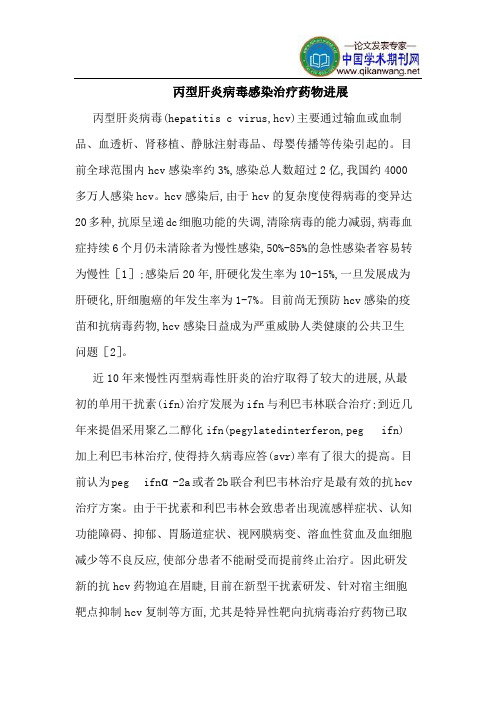
丙型肝炎病毒感染治疗药物进展丙型肝炎病毒(hepatitis c virus,hcv)主要通过输血或血制品、血透析、肾移植、静脉注射毒品、母婴传播等传染引起的。
目前全球范围内hcv感染率约3%,感染总人数超过2亿,我国约4000多万人感染hcv。
hcv感染后,由于hcv的复杂度使得病毒的变异达20多种,抗原呈递dc细胞功能的失调,清除病毒的能力减弱,病毒血症持续6个月仍未清除者为慢性感染,50%-85%的急性感染者容易转为慢性[1];感染后20年,肝硬化发生率为10-15%,一旦发展成为肝硬化,肝细胞癌的年发生率为1-7%。
目前尚无预防hcv感染的疫苗和抗病毒药物,hcv感染日益成为严重威胁人类健康的公共卫生问题[2]。
近10年来慢性丙型病毒性肝炎的治疗取得了较大的进展,从最初的单用干扰素(ifn)治疗发展为ifn与利巴韦林联合治疗;到近几年来提倡采用聚乙二醇化ifn(pegylatedinterferon,peg ifn)加上利巴韦林治疗,使得持久病毒应答(svr)率有了很大的提高。
目前认为peg ifnα-2a或者2b联合利巴韦林治疗是最有效的抗hcv 治疗方案。
由于干扰素和利巴韦林会致患者出现流感样症状、认知功能障碍、抑郁、胃肠道症状、视网膜病变、溶血性贫血及血细胞减少等不良反应,使部分患者不能耐受而提前终止治疗。
因此研发新的抗hcv药物迫在眉睫,目前在新型干扰素研发、针对宿主细胞靶点抑制hcv复制等方面,尤其是特异性靶向抗病毒治疗药物已取得可喜进展,部分药物已进入ⅱ、ⅲ期临床试验阶段[3]。
本文将主要介绍这几个领域丙肝药物研发的新进展。
1 干扰素及其新型修饰物的研发干扰素(interferon,ifn)是人和动物细胞受到适宜的刺激时产生的一种具有较强生物学活性的微量蛋白,可分为ⅰ型、ⅱ型和ⅲ型。
ifn2α属ⅰ型干扰素,是由单核细胞产生的相对分子量为18 000的多肽,是治疗慢性病毒性肝炎的主要药物之一,其疗效明确,可明显改善慢性乙肝和丙肝患者的长期预后,原发性肝癌的发生率明显降低。
- 1、下载文档前请自行甄别文档内容的完整性,平台不提供额外的编辑、内容补充、找答案等附加服务。
- 2、"仅部分预览"的文档,不可在线预览部分如存在完整性等问题,可反馈申请退款(可完整预览的文档不适用该条件!)。
- 3、如文档侵犯您的权益,请联系客服反馈,我们会尽快为您处理(人工客服工作时间:9:00-18:30)。
丙肝治疗新进展时间:2008-3-18 17:06:56 来源:国际肝病点击次数:54HEPATOLOGY DIGEST:In your clinic practice, how do you determine treatment duration of peg-interferon plus ribavirin?《国际肝病》:在临床实践中,您是怎样决定长效干扰素和利巴韦林联合治疗的疗程的?Prof. Maddrey:We are very interested in using the labeled virus at 4 weeks and 12 weeks to make our decisions. If patients have no detectable virus at 4 weeks, those patients generally regardless of suggested time can be treated for 6 months or less. If the patient is positive at 4 weeks and become negative at 12 weeks for genotype 1, we treat them for one year. For genotype 2 or 3, we generally treat them for 6 months.Maddrey教授:我们主要是通过检测4周和12 周的病毒载量来决定治疗疗程。
如果患者在第4周检测不出病毒,我们通常认为这些患者可以治疗6个月或更短的时间。
如果患者在第4周阳性而在12周阴性,对于基因1型患者我们通常将治疗疗程延至1年;而对于基因2型和3型患者我们通常治疗6个月。
HEPATOLOGY DIGEST:Are there any differences in genotype 1, 2 and 3 patients with HCV on treatment?《国际肝病》:关于基因1型、2型和3型丙型肝炎患者在治疗上有哪些不同之处呢?Prof. Maddrey:Yes, the differences are considerable. Genotype 2 responds to treatment in 6 month or less. Eighty to eighty-five percent of the time with sustained getting off virus. But for genotype 1 ,it is 45 to 50 percent patient clear completely in the one year. In genotype 3 , we get about 75 percent clearance in 6 month. So there are differences based on the genotype but very important.Maddrey教授:是的,他们之间的差别是非常显著的。
基因2型患者通常在6个月或更短的时间内对治疗产生应答。
80%~85%的时间他们具有持续的病毒清除能力。
但对基因1型,只有45%~50%的患者在1年以内能彻底清除病毒。
而在基因3型,我们发现约75%的患者可以在6个月时清除病毒。
所以不同基因型之间是有差别的,而且这种差别很重要。
HEPATOLOGY DIGEST:How do you think the new advance in this AASLD?《国际肝病》:您是怎样看待今年的美国肝病学会年会的新进展的?Prof. Maddrey :I think the major advances this year and next year all will be the introduction of small molecules that inhibit the proteinase of hepatitis virus. I think that will be the next great advance. What other people think will be the polymerase which are small molecules in the fusion replications of viruses by setting polymerase. Since I hope within 5 years, there are 3 or more proteases we can start to choose and pick based on the patient’s needs.Maddrey教授:我认为今年乃至明年的主要进展都将是——能抑制肝炎病毒的小分子蛋白酶的发现。
这可能是下一个巨大的进展。
也有人认为是聚合酶,他们是通过释放聚合酶影响病毒融合复制过程的小分子蛋白酶。
因此我希望在未来5年的时间内,能有3个甚至更多的小分子蛋白酶让我们依据患者的需要进行选择。
丙型肝炎患者合并胰岛素抵抗及脂肪肝时的管理HEPATOLOGY DIGEST:Please talk about the management of insulin resistanceand fatty liver disease in hepatitis C.《国际肝病》:请您谈谈丙型肝炎患者合并胰岛素低抗及脂肪肝时的管理。
Prof. Jensen: We currently have no good therapies for fatty liver disease except with genotype 3 hepatitis C virus infection. Genotype 3 HCV is different from the other hepatitis c genotypes in terms of fatty liver disease. In genotype 3, fatty liver disease has been shown to be related to virus replication. If we successfully treat and eradicate the virus, the fatty liver also goes away. For other hepatitis C viruses, specifically genotype 1, treating the virus is more difficult if fat is present. Second, when the virus is successfully treated, fat may still be present in the liver: it doesn’t go away with successful treatment. It may decrease slightly during therapy, but it doesn’t go away. Fatty liver may be related to the metabolic syndrome. The cornerstone of treatment is to change life style, so the patient is able to lose weight through diet and exercise. Maybe before they start therapy, they can control the body weight. There is evidence that if they can decrease the fatty liver disease, they also decrease the fibrosis. So perhaps improving metabolic syndrome might be associated with a better response to the interferon. We just don’t know that for certain yet, it has not been studied prospectively. But this is something that needs to be done.Jensen教授:目前对非基因型3型的慢性丙型肝炎合并脂肪肝的患者还没有特别满意的治疗方案。
合并脂肪肝的HCV患者,基因3型与其他类型不同,其脂肪肝与病毒复制相关。
如果经过治疗彻底清除病毒,那么脂肪肝也随之消失。
但是,对其他基因型特别是基因1型的HCV患者,当脂肪肝存在时清除病毒就十分困难,即使抗病毒治疗成功,脂肪肝也可能不会消失。
脂肪肝和代谢综合征存在一定相关性,所以首要的治疗就是改变生活方式,通过饮食控制和锻炼来控制体重。
患者最好在开始药物治疗之前已经将体重控制在正常范围。
有证据显示,脂肪肝减轻的同时肝纤维化也会有所减轻。
另外,改善代谢综合征后患者对干扰素治疗的应答也会提高。
但目前还没有这样前瞻性的研究在进行。
HEPATOLOGY DIGEST:What is the relationship between nonalcoholic fatty liver and metabolic syndrome ?《国际肝病》:非酒精性脂肪肝(NAFL)与代谢综合征(MS)的有什么关系?Prof. Jensen: Patients can have fatty liver from a number of causes. One of them is the metabolic syndrome. In many people, fatty liver can be associated with obesity or alcohol: they may have fatty liver, but not metabolic syndrome. They do not necessarily have insulin resistance. When we talk about the metabolic syndrome, we are really speaking about those patients who have insulin resistance. In simple terms, insulin resistance means that a higher level of insulin is required to do the things that it is normally required to perform in the body. As a feed back mechanism, the fatty liver itself can be associated with some insulin resistance. In addition, primary changes in certain inflammatory cytokines may also be associated with the insulin resistance. Many of NAFLD patients do have metabolic syndrome,but not all of them.Jensen教授:脂肪肝的原因有很多,代谢综合征只是其中的一个。
